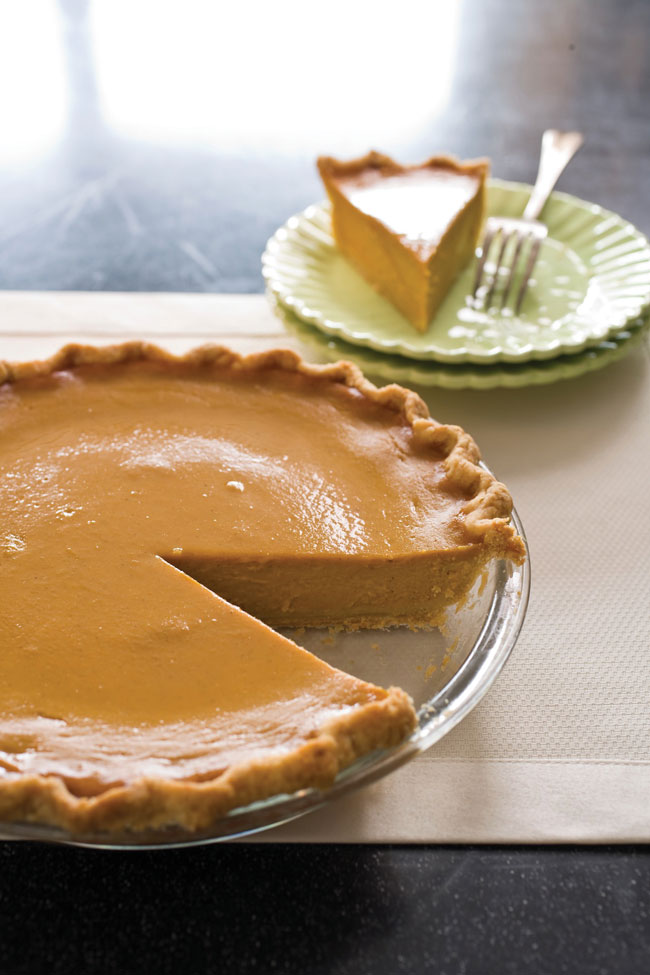
Every girl has one — that guy that she’s “just friends” with. You’ve known each other for I-don’t-know-how-many years, but you’ve never once been attracted, because you’ve always been, and always will be, “just friends.” All your best friends and family love him. You don’t not like him. You want to like him. But there’s something missing. That spark. That je ne sais quoi.
Pumpkin pie is like that guy. I don’t love pumpkin pie, but I so desperately want to. I love all things pumpkin. I love cinnamon, cloves, ginger, and nutmeg with pumpkin in breads, muffins, and pancakes.
I like pumpkin pie. When it’s around, I eat it without thinking twice. I mean, it’s still a pie. I’ll even eat leftover pumpkin pie sitting in the refrigerator; not even bothering to remove the pie from that middle shelf because I’ve contorted my body to prop open the refrigerator door while I sneak five or six bites straight from the pie dish with my fork.
Still, it drives me mildly insane trying to understand why other people go bonkers over pumpkin pie. Usually, the crust looks and tastes like soggy cardboard, and the filling, which can be wonderfully fragrant and flavorful, has the mealy, squishy consistency of baby food.
I want to love pumpkin pie. I want to look forward to the prospect of it with eager, heart-pounding anticipation as soon as the calendar flips from September to October. Pumpkin pie comes around only once a year, and I want a spring and summer absence to make my heart grow fonder. But it doesn’t. And then something happened. I ran into a recipe from Cook’s Illustrated for the perfect pumpkin pie. It promises a flaky, crisp crust. It promises a smooth, delicious, and firm filling. I baked it, unsure of how I’d end up feeling.
After a little more effort than the Libby’s-like recipes we’re used to, I slipped it gently into the oven. When it came out, I let it cool down. I pierced through that soft, quivering custard with an 8-inch chef’s knife and pulled out a perfect, enormous piece. It was heavy. I put the piece on a plate, and I took a bite.
After all these years, I finally fell in … like. A very, very strong like. The spark was finally lit. Pumpkin pie and I? There’s a little something going on between us now.
Pumpkin Pie
Recipes courtesy America’s Test Kitchen
(Makes 8 servings)
Make sure to buy unsweetened canned pumpkin; avoid pumpkin pie mix. If candied yams are unavailable, regular canned yams can be substituted. When the pie is properly baked, the center 2 inches of the pie should look firm but jiggle slightly. The pie finishes cooking with residual heat; to ensure that the filling sets let it cool at room temperature and not in the refrigerator.
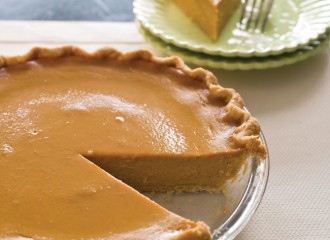
Ingredients
-
1 cup heavy cream
1 cup whole milk
3 large eggs plus 2 large yolks
1 teaspoon vanilla extract
1 (15‑ounce) can unsweetened pumpkin puree
1 cup candied yams, drained
¾ cup (5 ¼ ounces) sugar
¼ cup maple syrup
2 teaspoons grated fresh ginger
1 teaspoon salt
½ teaspoon ground cinnamon
¼ teaspoon ground nutmeg
1 recipe single-crust pie dough, fully baked and still warm (recipe on right)
Directions
-
Adjust oven rack to lowest position and heat oven to 400°F.
Whisk cream, milk, eggs, and yolks, and vanilla together in bowl.
Bring pumpkin puree, yams, sugar, maple syrup, ginger, salt, cinnamon, and nutmeg to simmer in large saucepan and cook, stirring constantly and mashing yams against sides of pot, until thick and shiny, 15 to 20 minutes.
Remove saucepan from heat and whisk in cream mixture until fully incorporated.
Strain mixture through fine-mesh strainer into bowl, using back of ladle or spatula to press solids through strainer. Whisk mixture, then pour into warm prebaked pie crust.
Place pie on rimmed baking sheet and bake for 10 minutes. Reduce oven temperature to 300°F and continue to bake until edges of pie are set and center registers 175°F, 20 to 35 minutes longer.
Let pie cool on wire rack to room temperature, about 3 hours. Serve.
Foolproof Single-Crust Pie Dough
(Makes one 9‑inch pie crust)
Vodka is essential to the tender texture of this crust and imparts no flavor — do not substitute water. This dough is moister than most standard pie doughs and will require lots of flour to roll out (up to 1/4 cup). A food processor is essential for making this dough — it cannot be made by hand.
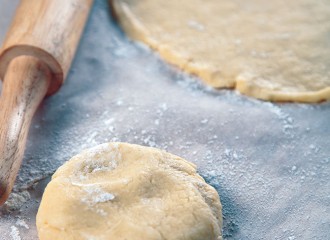
Ingredients
-
1 1/4 cups (6 ¼ ounces) all-purpose flour
1 tablespoon sugar
½ teaspoon salt
6 tablespoons (3/4 stick) unsalted butter, cut into 1/4‑inch pieces and chilled
4 tablespoons (1/4 cup) vegetable shortening, cut into 2 pieces and chilled
2 tablespoons vodka, chilled
2 tablespoons ice water
Directions
- Process 3/4 cup flour, sugar, and salt in food processor until combined, about 5 seconds. Scatter butter and shortening over top and continue to process until incorporated and mixture begins to form uneven clumps with no remaining floury bits, about 10 seconds.
Scrape down bowl and redistribute dough evenly around processor blade. Sprinkle remaining ½ cup flour over dough and pulse until mixture has broken up into pieces and is evenly distributed around bowl, 4 to 6 pulses. Transfer mixture to medium bowl. Sprinkle vodka and ice water over mixture. Stir and press dough together, using stiff rubber spatula, until dough sticks together.
Turn dough onto sheet of plastic wrap and flatten into 4‑inch disk. Wrap tightly in plastic and refrigerate for 1 hour. Before rolling out dough, let it sit on counter to soften slightly, about 10 minutes. (Dough can be wrapped tightly in plastic and refrigerated for up to 2 days or frozen for up to 1 month. If frozen, let dough thaw completely on counter before rolling it out.)
Adjust oven rack to middle position and heat oven to 425°F. Roll dough into 12‑inch circle on floured counter. Loosely roll dough around rolling pin and gently unroll it onto 9‑inch pie plate, letting excess dough hang over edge. Ease dough into plate by gently lifting edge of dough with your hand while pressing into plate bottom with your other hand. Leave any dough that overhangs plate in place. Wrap dough-lined pie plate loosely in plastic and refrigerate until dough is firm, about 30 minutes.
Trim overhang to ½ inch beyond lip of pie plate. Tuck overhang under itself; folded edge should be flush with edge of pie plate. Crimp dough evenly around edge of pie plate using your fingers. Wrap dough-lined pie plate loosely in plastic and refrigerate until dough is fully chilled and firm, about 15 minutes, before using. Line chilled pie shell with parchment paper or double layer of aluminum foil, covering edges to prevent burning, and fill with pie weights.
For a partially baked crust: Bake until pie dough looks dry and is pale in color, about 15 minutes. Remove weights and parchment and continue to bake crust until light golden brown, 4 to 7 minutes longer. Transfer pie plate to wire rack. (Crust must still be warm when filling is added.)
For a fully baked crust: Bake until pie dough looks dry and is pale in color, about 15 minutes. Remove weights and foil and continue to bake crust until deep golden brown, 8 to 12 minutes longer.
Per Serving
Calories: 545
Total Fat: 31 g
Saturated Fat: 16 g
Sodium: 597 mg
Carbohydrate: 60 g
Fiber: 4 g
Protein: 8.4 g
Diabetic Exchanges: 4 carbohydrate, 6 fat
Cook the Pumpkin
To maximize flavor, we at America’s Test Kitchen, publisher of Cook’s Illustrated, concentrate the pumpkin’s liquid rather than remove it, and we’ve found it best to do this on the stove — an added bonus for the spices that we add to the filling as well. Cooking the fresh ginger and spices along with the pumpkin puree intensifies their taste — the direct heat blooms their flavors. Cooking minimizes the mealy texture in this pie where pumpkin is the star.
Supplement with Yams
When we used solely pumpkin puree, we craved more flavor complexity. We experimented with roasted sweet potatoes, which added a surprisingly deep flavor without a wholly recognizable taste. To streamline this technique, we tried adding canned sweet potatoes — often labeled yams — instead. The yams add a complex flavor that complements the pumpkin.
Add Extra Yolks
Our goal with this pie was to eliminate the grainy texture that plagues most custard in favor of a creamy, sliceable, not-too-dense pie. We start with a balance of whole milk and cream, and firm up the mixture with eggs. We don’t simply add whole eggs, though — that just makes the pie too eggy. Because the whites are filled with much more water than the yolks, we exchange some whole eggs for yolks alone. Don’t forget to pass mixed filling through a fine-mesh strainer. This will ensure the ultimate smooth texture.
Add Hot Filling to Warm Crust
If you’re tempted to bake the pie crust way ahead of time, don’t. It’s imperative that the pie crust is warm when you add the hot filling. If it is not, the pie will become soggy. Using a hot filling in a warm crust allows the custard to firm up quickly in the oven, preventing it from soaking into the crust and turning it soggy. Keep that crust warm!
Turn the Oven High to Low
Most pumpkin pie recipes call for a high oven temperature to expedite cooking time. But as we’ve learned, baking any custard at high heat has its dangers. Once the temperature of custard rises above 185°F it curdles, turning the filling coarse and grainy. This is why we cannot bake the pie at 425°F, as most recipes suggest. Lowering the temperature to 350°F only produces a pie that is curdled and overcooked at the edges and still underdone in the center. But baking at a low 300°F would mean leaving the pie in the oven for 2 hours. What to do? We combine the two techniques, blasting the pie for 10 minutes on high heat and then baking it at 300°F for the rest of the baking time. This lessens the cooking time exponentially and leaves us with a creamy pie that’s fully and evenly cooked from edge to center.
Become a Saturday Evening Post member and enjoy unlimited access. Subscribe now
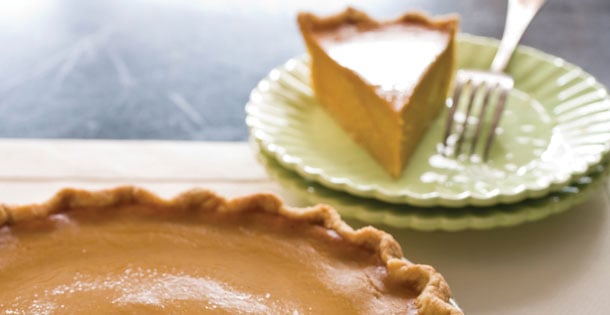
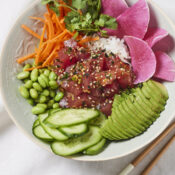
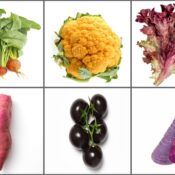
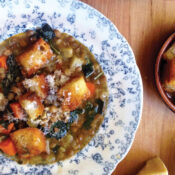
Comments
My main component, native one,
From Americas, Greek to me,
As in melon cooked by the sun.
Thanks to smart folks, I came to be.
And now am a Thanksgiving must,
And popular in poem and song.
I am an icon people trust
To spice the holidays along.
The world’s largest of me was made
Twenty ten, Bremen, Ohio,
Thirty eight hundred pounds I weighed,
Twenty feet diameter – whoa!
What a piece of work. What am I?
I, of course, am a pumpkin pie.
love me a good pumpkin pie. an okay pumpkin pie, not so much. homemade whipped cream…is icing … on the pie. great write up sarah!
Yams and sweet potatoes are not the same. They look almost alike and taste very similar, but one is a root and the other a tuber.